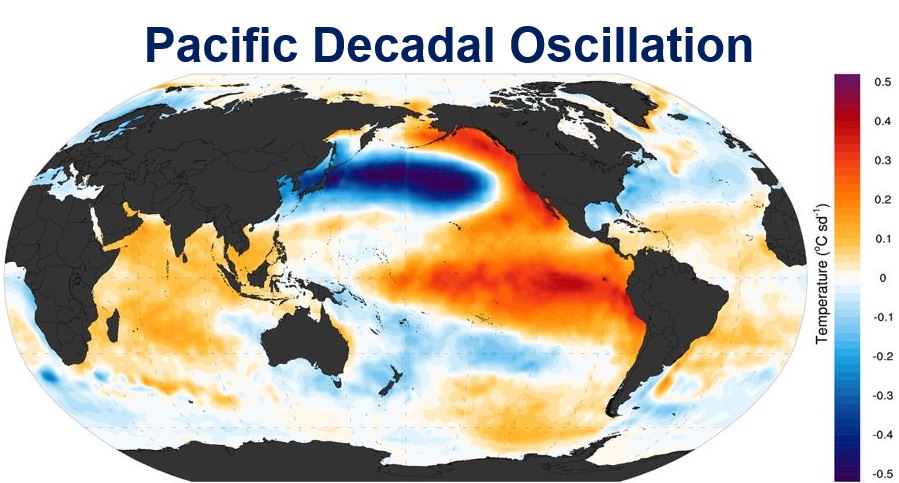The reason global warming has slowed down is the cooler Pacific Ocean, which for the last two decades has been Earth’s air conditioner – but this is a “false pause”, scientists warn. The relief will soon end, after which climate warming, which appears to be caused by human activity, will continue apace, they add.
Michael Mann, Distinguished Professor of Meteorology, Penn State, and colleagues explained that the recent slowdown in global warming is due partly to the natural oscillations in the climate.
These oscillations represent “variability to the internal climate system,” and do not suggest that human-caused global warming is abating.

Pacific Decadal Oscillation during the “warm phase”. (Image: Wikipedia)
Prof. Mann said:
“We know that it is important to distinguish between human-caused and natural climate variability so we can assess the impact of human-caused climate change on a variety of phenomena including drought and weather extremes.”
“The North Atlantic and North Pacific oceans appear to be drivers of substantial natural, internal climate variability on timescales of decades.”
Mann, Byron A. Steinman, assistant professor of geological sciences at Penn State, and researcher Sonya K. Miller, from the University of Minnesota-Duluth, gathered and analyzed a combination of real-world observational data and state-of-the-art climate model simulations to understand factors contributing to climate variability in the Northern Hemisphere during the historic era.
Their findings have been published in the journal Science (citation below).
The AMO (Atlantic Multidecadal Oscillation) describes how the temperatures of the sea-surface of the North Atlantic tend to oscillate over periods of 50 to 70 years.
The PDO (Pacific Decadal Oscillation) varies over a broader range of timescales. The research team only looked at the portion of PDO that was multidecadal – what they term PMO (Pacific Multidecadal Oscillation).
After running several climate simulations, they authors found that PMO and AMO are not significantly correlated – they are not, as some researchers had claimed, part of the global “stadium wave” oscillation.

Prof. Mann is Director of the Earth System Science Center at Penn State.
Slower warming due to the Pacific Ocean
The Northern Hemisphere was warming more slowly, they found, because of a sharply down-trending PMO, and not because of AMO (which was comparatively flat). In other words, global warming is being halted by the cooler Pacific Ocean.
The scientists concluded that the down-trending PMO and the unusual slowdown in global warming over the past ten years are tied to heat buried beneath the tropical Pacific and a tendency for sustained La Niña type conditions.
The authors wrote:
“While there is paleoclimate data suggesting that this type of response could come from subtle features of climate change itself that climate models do not currently capture, the researchers note that the most likely explanation is the random excursions of the AMO.”
Prof. Mann said:
“Our findings have strong implications for the attribution of recent climate changes. Internal multidecadal variability in Northern Hemisphere temperatures likely offset anthropogenic warming over the past decade.”
The researchers predict that the cooler Pacific Ocean’s recent halting of global warming will be short-lived, will reverse, and then add to human-induced warming in the future.
Citation: “Atlantic and Pacific multidecadal oscillations and Northern Hemisphere temperatures,” Byron A. Steinman, Michael E. Mann & Sonya K. Miller. Science. 27 February, 2015. DOI:10.1126/science.1257856.
